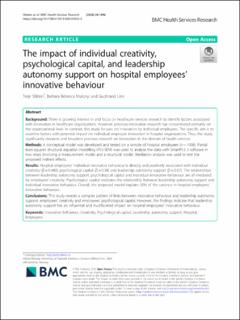| dc.contributor.author | Slåtten, Terje | |
| dc.contributor.author | Mutonyi, Barbara Rebecca | |
| dc.contributor.author | Lien, Gudbrand | |
| dc.date.accessioned | 2021-07-14T10:42:22Z | |
| dc.date.available | 2021-07-14T10:42:22Z | |
| dc.date.created | 2020-11-28T10:46:11Z | |
| dc.date.issued | 2020 | |
| dc.identifier.citation | BMC Health Services Research. 2020, 20 (1096), 1-17. | en_US |
| dc.identifier.issn | 1472-6963 | |
| dc.identifier.uri | https://hdl.handle.net/11250/2764386 | |
| dc.description.abstract | Purpose
The aim of this study is to explore how potentially traumatic events (PTEs) from war and flight influence health-related quality of life (HRQoL) in young refugees after recent resettlement. In a model based on earlier theory, we tested if post-migration stressors and mental distress mediated the effect of PTEs on HRQoL, individually and in serial. We also explored how different types of post-migration stressors influenced different dimensions of HRQoL.
Methods
This study used a cross-sectional design where 160 Syrian youth recently resettled in Norway completed questionnaires at school between May and December 2018. Correlations between types of post-migration stressors and dimensions of HRQoL were explored and a serial multiple mediator model was tested. Models were adjusted for age and gender, using two types of mental distress; post-traumatic stress disorder (PTSD) and general mental distress.
Results
Higher levels of PTEs reduced experienced HRQoL, but this direct effect was mediated by post-migration stressors alone and in serial with mental distress. Despite high levels of mental distress, this did not affect HRQoL independently, only in serial mediation with increased post-migration stressors. Economic concerns and discrimination were types of post-migration stressors affecting several dimensions of HRQoL.
Conclusion
Quality of life in refugee is affected by past events from war, stressors in current resettlement and elevated mental distress through complex interrelations. The study reiterates the importance of considering structural and everyday post-migration stressors in policy and intervention to improve the health and wellbeing of refugee youth. | en_US |
| dc.language.iso | eng | en_US |
| dc.rights | Navngivelse 4.0 Internasjonal | * |
| dc.rights.uri | http://creativecommons.org/licenses/by/4.0/deed.no | * |
| dc.title | The impact of individual creativity, psychological capital, and leadership autonomy support on hospital employees’ innovative behaviour | en_US |
| dc.type | Peer reviewed | en_US |
| dc.type | Journal article | en_US |
| dc.description.version | publishedVersion | en_US |
| dc.source.pagenumber | 1-17 | en_US |
| dc.source.volume | 20 | en_US |
| dc.source.journal | BMC Health Services Research | en_US |
| dc.source.issue | 1096 | en_US |
| dc.identifier.doi | 10.1186/s12913-020-05954-4 | |
| dc.identifier.cristin | 1853630 | |
| cristin.ispublished | true | |
| cristin.fulltext | original | |
| cristin.qualitycode | 2 | |

